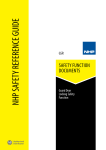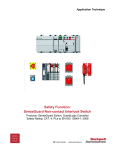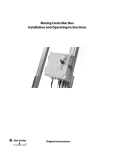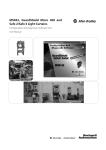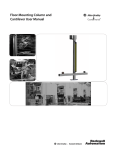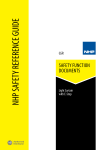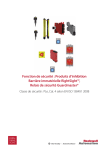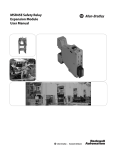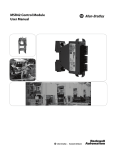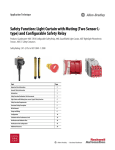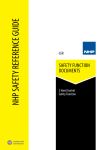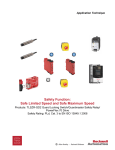Download Light Curtain Muting Safety Function
Transcript
NHP SAFETY REFERENCE GUIDE GSR SAFETY FUNCTION DOCUMENTS Light Curtain with Muting Safety Function Documents: GSR GuardMaster Safety Relay – Light Curtain Muting Safety Function Safety Rating: PLe, Cat. 4 to EN ISO 13849.1 2008 Table of Contents: Introduction 4-97 Important User Information 4-97 Safety Function Realization: Risk Assessment 4-98 Light Curtain Muting Safety Function 4-98 Safety Function Requirements 4-98 General Safety Information 5-99 Functional Safety Description 6-100 Bill of Material 6-101 Setup and Wiring 6-101 System Overview 6-102 Electrical Schematic 6-103 Configuration 6-104 Configure the GSR SI Safety Relay for Monitored Manual Reset 6-104 Configure the MSR42 Relay 6-105 Calculation of the Performance Level 6-110 Verification and Validation Plan 6-115 Additional Resources 6-119 NHP Safety Reference Guide > Safety Function Documents: GSR 6B-102 Safety Function Documents: GSR GuardMaster Safety Relay – Light Curtain Muting Safety Function Safety Rating: PLe, Cat. 4 to EN ISO 13849.1 2008 Introduction Important User Information This safety function application technique explains how to wire, configure, and integrate an MSR42 safety relay and an MSR45E expansion module with a GSR SI safety relay to monitor a 440L GuardShield™ light curtain to create a 2 Sensor L-type muting (single direction muting) system with an additional E-stop function. When an object interrupts the light curtain field of view, when it is not muted, or a fault is detected in the monitoring circuit, the MSR42 relay and MSR45E module de-energizes the redundant pair of 100S contactors, stopping the motion. Whenever the E-stop is pressed the GSR SI relay deenergizes the contactors, stopping the motion. Solid state equipment has operational characteristics differing from those of electromechanical equipment. Safety Guidelines for the Application, Installation and Maintenance of Solid State Controls (publication SGI-1.1 available from your local Rockwell Automation® sales office or online at http://www.rockwellautomation.com/literature) describes some important differences between solid state equipment and hard-wired electromechanical devices. Because of this difference, and also because of the wide variety of uses for solid state equipment, all persons responsible for applying this equipment must satisfy themselves that each intended application of this equipment is acceptable. When an object of the specified size passes the muting sensors in the proper sequence within the configured time interval, the light curtain is muted. The object is allowed to continue passing through the light curtain without the motion being stopped. Muting is terminated as soon as the object leaves the light curtain’s field of view. A mute dependant override capability is provided to clear objects stranded in the monitored area. When an object interrupts the light curtain’s field of view from the ‘non-muted’ direction, the MSR42 relay and MSR45E module de-energize the contactors. When an object approaches from the ‘muted’ direction and does not pass the muting sensors in the proper sequence or within the configured time interval, muting is not activated. In this case, the contactors are deenergized as soon as the object interrupts the light curtain’s field of view. In no event is Rockwell Automation, Inc., responsible or liable for indirect or consequential damages resulting from the use or application of this equipment. The examples and diagrams in this manual are included solely for illustrative purposes. Because of the many variables and requirements associated with any particular installation, Rockwell Automation, Inc., cannot assume responsibility or liability for actual use based on the examples and diagrams. No patent liability is assumed by Rockwell Automation, Inc., with respect to use of information, circuits, equipment, or software described in this manual. Reproduction of the contents of this manual, in whole or in part, without written permission of Rockwell Automation, Inc., is prohibited. NHP Safety Reference Guide > Safety Function Documents: GSR 6B-103 Safety Function Documents: GSR GuardMaster Safety Relay – Light Curtain Muting Safety Function Safety Rating: PLe, Cat. 4 to EN ISO 13849.1 2008 Safety Function Realization: Risk Assessment Safety Function Requirements The performance level required is the result of a risk assessment and refers to the amount of the risk reduction to be carried out by the safety-related parts of the control system. Part of the risk reduction process is to determine the safety functions of the machine. In this application, the performance level required (PLr) by the risk assessment is Category 3, Performance Level d (CAT. 3, PLd), for each safety function. A safety system that achieves CAT. 3, PLd or higher can be considered control reliable. Each safety product has its own rating and can be combined to create a safety function that meets or exceeds the PLr. Interrupting the light curtain stops and prevents hazardous motion by removing power to the motor. The motor coasts to a stop (Stop Category 0). Upon resetting the light curtain, hazardous motion and power to the motor does not resume until a secondary action (start button depressed) occurs. Muting the light curtain is done to allow automatically-fed material to enter the area. Multiple sensors are configured to detect the incoming material, and initiate and monitor the muting function per IEC/ TS 62046. Faults at the light curtain, muting sensors, wiring terminals or safety controller are detected before the next safety demand. The safe distance from the location of the light curtain to the hazard must be established per ISO 13855 so the hazardous motion is stopped before the user can reach the hazard. The safety function in this example is capable of connecting and interrupting power to motors rated up to 9 A, 600V AC. From: Risk Assessment (ISO 12100) 1 Identification of safety functions 2 Specification of characteristics of each safety function 3 Determination of required PL (PLr) of each safety function The safety function in this application technique meets or exceeds the requirements for Category 3, Performance Level “d” (CAT. 3, PLd), per EN ISO 13849-1 and control reliable operation per ANSI B11.19. Throughout this manual, when necessary, we use notes to make you aware of safety considerations. To: Realization and PL evaluation Light Curtain Muting Safety Function This application includes three safety functions: 1.Emergency stop of hazardous motion initiated by a light curtain. 2.Muting of a light curtain. 3.Emergency stop of hazardous motion initiated by an E-stop button. This system executes a Stop Category 0 stop. The motion is allowed to coast to a stop. NHP Safety Reference Guide > Safety Function Documents: GSR 6B-104 Safety Function Documents: GSR GuardMaster Safety Relay – Light Curtain Muting Safety Function Safety Rating: PLe, Cat. 4 to EN ISO 13849.1 2008 General Safety Information WARNING: Identifies information about practices or circumstances that can cause an explosion in a hazardous environment, which can lead to personal injury or death, property damage, or economic loss. Identifies information that is critical for successful application and understanding of the product. ATTENTION: Identifies information about practices or circumstances that can lead to personal injury or death, property damage, or economic loss. Attentions help you identify a hazard, avoid a hazard, and recognize the consequence. SHOCK HAZARD: Labels typically found on or inside equipment (for example, a drive or motor) to alert people that dangerous voltage can be present. BURN HAZARD: Labels typically found on or inside equipment (for example, a drive or motor) to alert people that surfaces can reach dangerous temperatures. Contact Rockwell Automation to find out more about our safety risk assessment services. This application example is for advanced users and assumes that you are trained and experienced in safety system requirements. ATTENTION: Perform a risk assessment to verify that all task and hazard conditions have been identified and addressed. The risk assessment can require additional circuitry to reduce the risk to a tolerable level. Safety circuits must consider safety distance calculations that are not part of the scope of this document. NHP Safety Reference Guide > Safety Function Documents: GSR 6B-105 Safety Function Documents: GSR GuardMaster Safety Relay – Light Curtain Muting Safety Function Safety Rating: PLe, Cat. 4 to EN ISO 13849.1 2008 Functional Safety Description Hazardous motion is stopped or prevented by interrupting the field of view of the light curtain or by errors in the muting sequence or timing. The 440L light curtain and two RightSight muting sensors are connected to the MSR42 safety relay. The MSR42 relay is mated to an MSR45E expansion module, which provides two NO safety contacts that control power to the 100S contactor coils via the GSR SI safety contacts. Whenever the MSR42/MSR45E opens the safety contacts, the hazardous motion is stopped. When all safety input signals are correct, no faults are detected, and the reset push button is pressed, the MSR42 energizes its safety contacts to provide power to the contactor coils via the GSR SI. The E-stop is connected to the GSR SI, which uses pulse checking to monitor the E-stop for actuation and faults. Whenever the E-stop is actuated, the GSR SI opens its safety contacts and the hazardous motion is stopped. When all safety input signals are correct, no faults are detected, and the reset push button is pressed (for 0.25 to 3.0 seconds) and then released, the GSR SI re-energizes its safety contacts to provide power to the contactor coils. In summary, when the un-muted light curtain is blocked, the contactors drop out. When the light curtain is unblocked and the appropriate reset button is pressed and released, the contactors are energized. When properly muted, the light curtain’s field of view can be interrupted without dropping out the safety contactors. Whenever the light curtain is muted, the muting lamp is energized. Bill of Material Cat. No. 440L-P4KL1280YD Description Qty GuardShield™ Safety Light Curtain, Res 30 mm, Pt Ht 1280 mm, 64 Beams, Integrated Laser Alignment 1 2 60-2649 92-89 DC Micro (M12), Female, Straight, 4-pin, PVC Cable, Yellow, Unshielded, 22 AWG, IEC Color Coded, No Connector, 2 m (6.56 ft) length DC Micro (M12), Female, Straight, 8-pin, PVC Cable, Yellow, Unshielded, 24 AWG, IEC Color Coded, No Connector, 2 m (6.56 ft) length PHOTOSWITCH® Photoelectric Sensor, RightSight, Polarized Retroflective, Red, DC - 2 Complementary LO/DO Outputs, Source (PNP), 4-pin DC Micro QD on 152 mm (6 in.) pigtail DC Micro (M12), Female, Straight, 4-pin, PVC Cable, Yellow, Unshielded, 22 AWG, IEC Color Coded, No Connector, 2 m (6.56 ft) length 60-2649 Swivel/Tilt Mounting Bracket 92-89 Reflector 440R-P226AGS-NNR MSR42 Multi-function Controller for GuardShield Light Curtains 1 889D-F4AC-2 889D-F8AB-2 42EF-P2MPB-F4 889D-F4AC-2 855EP-G24L5 445L-AF6150 440R-ACABL1 Control Tower Stack Light, Pre-assembled, 10 cm Pole Mount with Cap, Gray Housing, 24V AC/DC Full Voltage, Amber Flashing LED Optical Interface Tool (required to configure the MSR42) 1 1 2 2 2 1 1 Ribbon cable 10-pin for 1 extension MSR45E - Relay Extension (ribbon cables for 1, 2 or 3 MSR45 extension are ordered separately from the MSR45) 1 800F-1YP3 800F 1-hole Enclosure E-stop Station, Plastic, PG, Twist-to-release 40 mm, Non-illuminated, 2 N.C. 1 800F-BX10 N.O. Status Contact (add to 800F-1YP3) 1 440R-S12R2 Guardmaster Safety Relay, 1 Dual Channel Universal Input, 1 N.C. Solid State Auxiliary Outputs 1 800FM-G611MX10 800F Push Button - Metal, Guarded, Blue, R, Metal Latch Mount, 1 N.O. Contact(s), 0 N.C. Contact(s), standard, standard pack (qty. 1) 1 100S-C09EJ23C MCS 100S-C Safety Contactor, 9 A, 24V DC 2 440R-P4NANS 1 NHP Safety Reference Guide > Safety Function Documents: GSR 6B-106 Safety Function Documents: GSR GuardMaster Safety Relay – Light Curtain Muting Safety Function Safety Rating: PLe, Cat. 4 to EN ISO 13849.1 2008 Setup and Wiring Ds = K x (Ts + Tc + Tr – Tbm) + Dpf. For detailed information on installing and wiring, refer to the product manuals listed in the Additional Resources. K: the ‘standard’ hand speed of 63 inches per second Ts: the stop time of the machine A safety light curtain provides no physical barrier between a person and the hazardous motion. The safety light curtain must be installed at a sufficient distance from the hazardous motion to ensure that someone putting a hand through the light curtain cannot reach the hazard before it has stopped. This distance is referred to as the Safety Distance. Tc:the response time of the safety system; the MSR42 relay, MSR45E module, and K1/K2 contactors The Safety Distance (Ds) required varies from installation to installation and, therefore, must be calculated for each specific application. This application technique uses the ANSI formula: Dpf:the distance that a ‘standard’ hand could possibly move through the LC before it is detected. This is a fixed value based on the light curtain resolution Tr:the response time of the presence sensing device; the light curtain (LC) Tbm:additional time allowed for the brake monitor (if any) to compensate for variations in normal stopping time In this application technique, the values are: K: 63 inches per second Ts:500 ms – (0.5 sec.) is only for purposes of this application note. The stop time for a specific application must be measured Tc: 39 ms = 18 ms (MSR42) + 6 ms (MSR45E) + 15 ms (K1/K2) Tr: 20 ms = LC Tr + Tc = 20 + 39 = 59 ms = 0.059 sec. Tbm: 0 – none used in this application Dpf: 78.7 mm (3.1 inches) DS = (63 x 0.5 + 0.059]) + 3.1 = 38.3 inches The LC must not be mounted closer than 895 mm (35.24 in.) from the guarded hazard. The following is the same calculation using 13855: S = (K x T) + C S: minimum distance in millimeters (mm) K:is a parameter, in millimeters per second (mm/s), derived from data on approach speeds of the body or parts of the body T: is the overall stopping performance in seconds C: is the intrusion distance in mm In this application technique, the values are: K = 1600 mm per second T = 559 ms (Machine Stopping Time 500 ms + 20 ms [LC] + 18 ms [MSR42] + 6 ms [MSR45E] + 15 ms [K1/K2]) C = 8(d - 14) but not less than 0 where ‘d’ is the resolution of the LC S = 1600 x .559 + 8(14 - 14) The LC must not be mounted closer than 895 mm (35.24 in.) from the guarded hazard. NHP Safety Reference Guide > Safety Function Documents: GSR 6B-107 Safety Function Documents: GSR GuardMaster Safety Relay – Light Curtain Muting Safety Function Safety Rating: PLe, Cat. 4 to EN ISO 13849.1 2008 The MSR42 Configuration Software can also be used to calculate safety distances. System Overview A 2 Sensor L-type muting (single direction muting) system allows loads or objects to pass through its light curtains in one direction without shutting down the protected machine or process but will stop the protected machine or process if anything or anyone attempts to move past the light curtains in the other direction. The system will also shut down the protected machine when an object fails to satisfy the requirements for muting. 2 Sensor L-type muting is often used to guard the output area of a machine or process. Typical places where this form of muting would be typical are the exit of an automatic palletizing system or an automatic assembly machine. To initiate muting an object must pass, in sequence, sensor 1, then sensor 2 and finally, the light curtain. The time between the beam breaks is monitored and must not exceed the specified times. The overall time that the system is muted is likewise monitored. The protected system shuts down if any specified time is exceeded. The sensors and light curtain must be positioned so that all three are broken simultaneously at one point in the process. The sensors and light curtain must be restored in the same sequence as they were passed to initiate the muting sequence. A new object cannot start the process (break sensor 1) until the previous object has moved beyond the light curtain. The protected system shuts down if either sensor is broken before the previous object has moved beyond the light curtain. Muting is suspended as the object passes out of the light curtain field of view. The MSR42 relay monitors the 100S contactors via NC contacts from each contactor connected in series to provide a Start Release function. The MSR42 relay does not respond to its Start button and energize the MSR45E safety contacts when the light curtain is interrupted, there is a fault detected, or when the 100S contactors are not in the proper off state. The MSR42 runs and monitors a muting lamp. Should the lamp burn out or be removed, the MSR42 relay does not mute the light curtain. The GSR SI relay monitors the state of the E-stop push button. It checks for faults by connecting its pulse test outputs though the E-stop contacts and monitoring its inputs. The GSR SI relay monitors itself for internal faults. A fault in the E-stop circuit, an internal fault, or pressing the E-stop causes the GSR SI relay to open its safety contacts, shutting down the protected system. The GSR relay monitors the 100S contactors via NC contacts from each contactor connected in series as part of its reset circuit. The GSR SI relay does not respond to its reset button and energize its safety contacts when the E-stop button has not been released, a fault is detected, or when the 100S contactors are not in the proper off state. The 440L light curtain monitors itself and its outputs for faults and responds to any fault by turning off both of its outputs. The MSR42 relay monitors the light curtain outputs and the sensor outputs. The MSR42 relay verifies that it receives the sensors and light curtain signals in the proper sequence within the specified times. When the MSR42 relay detects any fault at its inputs or an internal fault, it de-energizes the MSR45E safety contacts, shutting down the protected system. NHP Safety Reference Guide > Safety Function Documents: GSR 6B-108 Safety Function Documents: GSR GuardMaster Safety Relay – Light Curtain Muting Safety Function Safety Rating: PLe, Cat. 4 to EN ISO 13849.1 2008 Electrical Schematic 24V* 0V* * Class 2 Source required +24V 0V 855EP-G24L5 Lamp A 440L-P4KL1280YD Brn Transmitter to PLC S2 Wht Status to PLC Grn Wht Pnk Status to PLC Blu Blu Blu Blu Blk * GPIO4 Gry Brn Brn MSR45E MSR42 Receiver Wht Status 42EF-P2MPB-F4 (2) S1 Brn GPIO3 Status to PLC Status to PLC Info1 Info2 GPIO2 Blk GPIO1 13 14 K1 K2 IN2 23 Start Status to PLC 24 IN1 A1 A2 E-Stop K1 K2 SI Status to PLC S11 Y32 S21 Status to PLC Status to PLC Status to PLC Reset 0 AM MM S12 Reset K1 S22 K2 Status to PLC S34 13 14 MSR42 = 440R-P226AGS-NNR *Ribbon Cable connector MSR42 to MSR 45E = 440R-ACABL1 MSR45E = 440R-P4NANS SI = 440R-S12R2 A1 K1 A2 A1 K2 A2 23 24 L11 L1 L2 L3 External Switched Stop/Start Circuit K1 K2 M NHP Safety Reference Guide > Safety Function Documents: GSR 6B-109 Safety Function Documents: GSR GuardMaster Safety Relay – Light Curtain Muting Safety Function Safety Rating: PLe, Cat. 4 to EN ISO 13849.1 2008 Configuration The 440L light curtain features DIP switches to configure it for different applications. This application uses the default settings so no DIP switch changes are necessary. Receiver - Factory Settings Switch 1 Switch Function Default Setting Description ON 2 Mode Activation - Combination activates one of the following modes: Guard Only, Start Interlock, Restart Interlock ON 3 MPCE: Monitoring Disable ON Disabled 4 Fixed Blanking Activate OFF Disabled 5 Floating Blanking Activate - Single Beam OFF 6 Floating Blanking Activate - Two Beams OFF 7 Set Beam Coding OFF 8 Not Used OFF Guard Only Switches 5&6 cannot be activated “On” at the same time Disabled Transmitter - Factory Settings Switch Switch Function Default Setting 1 Set Beam Coding OFF 2 Machine Test Signal OFF Description Disabled OFF: Signal High Active–No connection or connect normally open ON: Signal Low Active–Connect N/C 0 Configure the GSR SI Safety Relay for Monitored Manual Reset AM The following procedure sets the function of the drive: 1.Start configuration/overwrite: With power off, turn the rotary switch to position “0” and unit is powered up. After power-up test, the PWR status indicator flashes red. MM 2.Set configuration: Turn the rotary switch to the desired position. The IN1 status indicator blinks the new setting. NOTE: Position is set when PWR status indicator is solid green. 0 3.Lock in configuration by cycling unit power. 4.Configuration must be confirmed before operation. A white space on the face of the device is provided to record unit setting. AM MM NHP Safety Reference Guide > Safety Function Documents: GSR 6B-110 Safety Function Documents: GSR GuardMaster Safety Relay – Light Curtain Muting Safety Function Safety Rating: PLe, Cat. 4 to EN ISO 13849.1 2008 Configure the MSR42 Relay Follow these steps to configure the MSR42 relay. 4.From the GPIO pull-down menu, choose Muting other device (OSSDs). 1.Open the MSR42 configuration software. Refer to Configuring GSR SI Safety Relay for Monitored Manual Reset, publication SAFETY-UM001. 5. A safety notice appears. Click OK to continue. 2. On the software home screen, click MSR42. 6. The Muting screen appears. Click the 2 sensor L-type tab. 3. On the MSR42 configuration screen, click the Configuration tab. NHP Safety Reference Guide > Safety Function Documents: GSR 6B-111 Safety Function Documents: GSR GuardMaster Safety Relay – Light Curtain Muting Safety Function Safety Rating: PLe, Cat. 4 to EN ISO 13849.1 2008 Configure the MSR42 Relay (cont) 7. In the Time Settings area, set the following: t(sens) [s] to 3.6 seconds. t(espe) [s] to 3 seconds. t(mute) [min] to 3 minutes. t(mdo) [s] to 30 seconds. Leave t(msdel) [s] set at 0.050. TIP: Click the question mark box in the Time Settings area for an explanation of each time setting. 8.Click OK to save your changes and return to the MSR42 configuration screen. NHP Safety Reference Guide > Safety Function Documents: GSR 6B-112 Safety Function Documents: GSR GuardMaster Safety Relay – Light Curtain Muting Safety Function Safety Rating: PLe, Cat. 4 to EN ISO 13849.1 2008 Configure the MSR42 Relay (cont) 9.On the Configuration tab, set the following: From the IN1 pull-down menu, choose Start. From the IN2 pull-down menu, choose Start Release. Notice that the design error messages data field now says Design OK. 10. From the File menu, choose Configuration control document. NHP Safety Reference Guide > Safety Function Documents: GSR 6B-113 Safety Function Documents: GSR GuardMaster Safety Relay – Light Curtain Muting Safety Function Safety Rating: PLe, Cat. 4 to EN ISO 13849.1 2008 Configure the MSR42 Relay (cont) Notice that the document includes the times set in step 7 and response times used in the Safety Distance calculation on page 7. 11. Click Print to include this information as part of the system documentation. Refer to Configuring GSR SI Safety Relay for Monitored Manual Reset, publication SAFETY-UM001, for how to connect the optical interface between your personal computer (PC) and the MSR42 relay so you can download the created configuration to the MSR42 relay. 12.The download sequence requires you to enter the MSR device number. The serial number can be found on the side of the MSR42. NHP Safety Reference Guide > Safety Function Documents: GSR 6B-114 Safety Function Documents: GSR GuardMaster Safety Relay – Light Curtain Muting Safety Function Safety Rating: PLe, Cat. 4 to EN ISO 13849.1 2008 Configure the MSR42 Relay (cont) 13. When communication is established, choose File > PC -> MSR42 (Download). 14. For the password, type ABGM (all CAPITAL letters) and click OK. The download proceeds. NHP Safety Reference Guide > Safety Function Documents: GSR 6B-115 Safety Function Documents: GSR GuardMaster Safety Relay – Light Curtain Muting Safety Function Safety Rating: PLe, Cat. 4 to EN ISO 13849.1 2008 Calculation of the Performance Level The project’s functional safety specifications call for a structure of Cat 3 (minimum) and a PLr of PLd (minimum). A PFHd of less than 1.0 E-06 for the overall safety function is required for PLd. This SISTEMA project includes three safety functions. 1.Emergency stop of hazardous motion initiated by a light curtain. 2.Muting of a light curtain. 3.Emergency stop of hazardous motion initiated by an E-stop button. The individual safety function’s achieved performance level (PL) values are shown below. In this system, the PL achieved by each safety function is higher than the PLr required (PLd per EN ISO 13849-1:2008) by the risk assessment. Electromechanical devices, like E-stop buttons and safety contactors, have limited operational lives directly related to how often they are operated. In the following calculations, it is presumed that: The E-stop button is operated 730 (365 X 2) times a year. Safety contactors operate a total of 8,760 (24 X 365) times a year.1 All other components are electronic and thus have an essentially infinite operational life. The emergency stop of hazardous motion initiated by a light curtain’s safety function can be modeled as below. INPUT LOGIC OUTPUT 100S K1 Light Curtain Safety Function Light Curtain MSR42 MSR45E 100S K2 Subsystem 1 Subsystem 2 Subsystem 3 Subsystem 4 NHP Safety Reference Guide > Safety Function Documents: GSR 6B-116 Applies to safety contactors where their operation can be the result of power up/reset, an E-stop being pressed, the light curtain’s field of view being interrupted, or an error in the muting process. 1 Safety Function Documents: GSR GuardMaster Safety Relay – Light Curtain Muting Safety Function Safety Rating: PLe, Cat. 4 to EN ISO 13849.1 2008 Calculation of the Performance Level (cont) The functional safety data for the emergency stop of hazardous motion initiated by a light curtain’s safety function is as follows. The functional safety data for the light curtain’s subsystem is as follows. The functional safety data for the MSR42 relay’s logic subsystem is as follows. The functional safety data for the MSR45E relay’s logic subsystem is as follows. The functional safety data for the 100S contactor’s output subsystem is as follows. NHP Safety Reference Guide > Safety Function Documents: GSR 6B-117 Safety Function Documents: GSR GuardMaster Safety Relay – Light Curtain Muting Safety Function Safety Rating: PLe, Cat. 4 to EN ISO 13849.1 2008 Calculation of the Performance Level (cont) The muting of a LC’s safety function can be modeled as follows. INPUT LOGIC OUTPUT 100S K1 Sensor Block MSR42 Muted Light Curtain Safety Function MSR45E Light Curtain Block Subsystem 1 100S K2 Subsystem 2 Subsystem 3 Subsystem 4 The functional safety data for the muting of a LC’s safety function is as follows. The functional safety data for the muting sensors’ input subsystem is as follows. The functional safety data for the light curtain’s input subsystem is as follows. The functional safety data for the MSR42 relay’s logic subsystem is as follows. NHP Safety Reference Guide > Safety Function Documents: GSR 6B-118 Safety Function Documents: GSR GuardMaster Safety Relay – Light Curtain Muting Safety Function Safety Rating: PLe, Cat. 4 to EN ISO 13849.1 2008 Calculation of the Performance Level (cont) The functional safety data for the MSR45E relay’s logic subsystem is as follows. The functional safety data for the 100S contactor’s output subsystem is as follows. Emergency stop of hazardous motion initiated by an E-stop button can be modeled as follows. INPUT LOGIC 100S K1 E-Stop 1 B1/E1 E-Stop Safety Function OUTPUT GSR SI E-Stop 1 B2/E2 Sub-system 1 100S K2 Sub-system 2 Sub-system 3 The functional safety data for the emergency stop of hazardous motion initiated by an E-stop button safety function is as follows. NHP Safety Reference Guide > Safety Function Documents: GSR 6B-119 Safety Function Documents: GSR GuardMaster Safety Relay – Light Curtain Muting Safety Function Safety Rating: PLe, Cat. 4 to EN ISO 13849.1 2008 Calculation of the Performance Level (cont) The functional safety data for the E-stop button’s input subsystem is as follows. The functional safety data for the GSR SI logic subsystem is as follows. The functional safety data for the 100S safety contactor’s output subsystem is as follows. The E-stop and safety contactors data includes MTTFd, DCavg, and CCF data because they are electromechanical devices. Electromechanical device functional safety evaluations include how frequently they are operated, whether they are effectively monitored for faults, and properly specified and installed. SISTEMA calculates the MTTFd by using B10d data provided for the contactors with the estimated frequency of use entered during the creation of the SISTEMA project. The DCavg (99%) for the contactors was selected from the Output Device table of EN ISO 13849-1 Annex E. “Direct Monitoring”. The DCavg (99%) for the E-stop was selected from the Input Device table of EN ISO 13849-1 Annex E. “Cross Monitoring”. The (CCF) value is generated using the scoring process outlined in Annex F of ISO 13849-1. The complete CCF scoring process must be done when actually implementing an application. A minimum score of 65 points must be achieved. NHP Safety Reference Guide > Safety Function Documents: GSR 6B-120 Safety Function Documents: GSR GuardMaster Safety Relay – Light Curtain Muting Safety Function Safety Rating: PLe, Cat. 4 to EN ISO 13849.1 2008 Verification and Validation Plan Verification and validation play an important role in avoiding faults throughout the safety system design and development process. ISO/EN 13849-2 sets the requirements for verification and validation, which calls for a documented plan to confirm all safety functional requirements are met. Verification is an analysis of the resulting safety control system. The Performance Level (PL) of the safety control system is calculated to confirm it meets the Required Performance Level (PLr) specified. The SISTEMA software tool is typically used to perform the calculations and assist with satisfying ISO 13849-1 requirements. Validation is a functional test of the safety control system to demonstrate that it meets the specified requirements of the safety function. The safety control system is tested to confirm all safety-related outputs respond appropriately to their corresponding safety-related inputs. The functional test should include normal operating conditions and potential fault inject of failure modes. A checklist is typically used to document the validation of the safety control system. Prior to validating the GSR Safety Relay system, it is necessary to confirm the GSR Relay has been wired and configured in accordance with the Installation Instructions. NHP Safety Reference Guide > Safety Function Documents: GSR 6B-121 Safety Function Documents: GSR GuardMaster Safety Relay – Light Curtain Muting Safety Function Safety Rating: PLe, Cat. 4 to EN ISO 13849.1 2008 Verification and Validation Checklist GENERAL MACHINERY INFORMATION Machine Name / Model Number Machine Serial Number Customer Name Test Date Tester Name(s) Schematic Drawing Number Light Curtain Pair Specialty Safety Relay Specialty Expansion Relay Guardmaster Safety Relay Model 440L-P4KL1280YD 440R-P226AGS-NNR 440R-P4ANS 440R-S12R2 Safety Wiring and Relay Configuration Verification Test Step Verification 1 Visually inspect and verify that the safety relay circuit is wired as documented in the schematics. 2 Visually inspect the safety relay’s configuration switch settings are correct as documented. Pass/Fail Changes/Modifications Normal Operation Verification – The Safety System Performs as Intended in Response to Normal, Intended, Non-faulted Input Test Step Verification Pass/Fail 1 Verify that no one is in the hazard area. 2 Apply power to the safety system. 3 Verify that the motor is stopped. 4 Verify that nothing is on the conveyor. 5 Verify that the E-stop is released. 6 Verify that the four GPIO status indicators of the MSR42 relay are green. Verify that the OSSD1 and OSSD2 status indicators of the MSR42 relay are red. Verify that the IN1 and IN2 status indicators of the MSR42 relay are green. Verify that the FSD status indicator of the MSR45E module is red. 7 Press and release the MSR42 start button. Verify that the OSSD1 and OSSD2 status indicators turn green. Verify that the MSR45E module energizes its safety contacts. Verify that the FSD status indicator of the MSR45E module turns green. 8 Verify that the motor does not start on power up. 9 Verify that the PWR/Fault and IN status indicators of the GSR SI relay are green. 10 Verify that the OUT status indicator of the GSR SI relay blinks green. 11 Press and release the GSR SI reset button. The OUT status indicator of the GSR SI must turn on steady green. The GSR SI relay energizes its safety outputs. The conveyor starts. 12 Press the E-stop. The IN and OUT status indicators of the GSR SI relay must turn off. The GSR SI safety output must deenergize. The conveyor must stop. The MSR42 relay and MSR45E module must not respond. 13 Release the E-stop. The IN status indicator turns green. The OUT status indicator blinks green. The GSR SI safety output must NOT energize. The conveyor must NOT start. 14 Press and release the GSR SI reset button. The OUT status indicator must turn steady green. The GSR SI safety output must energize and the conveyor must start. 15 Move an object directly into the light curtain’s sensing plane. The MSR42 relay and MSR45E module must immediately de-energize their safety outputs. The conveyor must stop. The GSR SI must not respond. 16 Remove the object from the sensing plane. The MSR42 relay and MSR45E module must not energize their safety outputs. The conveyor must not start. 17 Press and release the MSR42 start button. The MSR42 relay and MSR45E module safety outputs must energize and the conveyor must start. 18 Place a typical unit on the conveyor moving toward the muting system. Observe that the muting sensors’ indicators respond as the unit passes between them and their reflectors. Verify that the muting lamp turns on. 19 The unit must pass through the light curtain’s sensing plane without the MSR42 relay and MSR45E module responding. Verify that the muting lamp turns off as the unit clears the light curtain’s sensing plane. Changes/Modifications NHP Safety Reference Guide > Safety Function Documents: GSR 6B-122 Safety Function Documents: GSR GuardMaster Safety Relay – Light Curtain Muting Safety Function Safety Rating: PLe, Cat. 4 to EN ISO 13849.1 2008 Verification and Validation Checklist (cont) Normal Operation Verification (continued) – The Safety System Performs as Intended in Response to Normal, Intended, Non-faulted Input (continued) Test Step Verification Pass/Fail 20 Place a typical unit on the conveyor moving toward the muting system. Block muting sensor 2 before the unit reaches muting sensor 1. Observe whether the muting lamp starts flashing after three seconds. Keep it blocked until the unit passes in front of it. Observe that when the unit reaches the light curtain sensing plane, the MSR42 relay and MSR45E module de-energize their safety outputs and the conveyor stops. Leave the unit where it stopped. 21 Make certain no one is in the hazard area. Press and release the MSR42 start button. The conveyor starts. The muting lamp turns on steady. Verify that as the unit moves out of the light curtain’s sensing plane, the muting lamp turns off. 22 Place a typical unit on the conveyor moving toward the muting system. Let the unit pass in front of muting sensor 1 and muting sensor 2. The muting lamp turns on steady. Hold the unit in place before it reaches the light curtain’s sensing plane. Observe if the muting lamp starts flashing after three seconds. Release the unit to continue along the conveyor. The MSR42 relay and MSR45E module de-energize their safety outputs immediately when the unit enters the light curtain’s sensing plane. Leave the unit where it stopped. 23 Make certain no one is in the hazard area. Press and release the MSR42 start button. The conveyor starts. The muting lamp turns on steady. As the unit moves out of the light curtain’s sensing plane, verify that the muting lamp turns off. 24 Place a typical unit on the conveyor moving toward the muting system. Let the unit pass in front of muting sensor 1 and muting sensor 2. The muting lamp turns on steady. Let the unit enter the light curtain’s sensing plane, which is now muted. Hold the unit in place part way through the light curtain’s sensing plane. Observe if the muting lamp starts flashing after three seconds. The MSR42 relay and MSR45E module de-energize their safety outputs and the conveyor stops. 25 Make certain no one is in the hazard area. Press and release the MSR42 start button. The conveyor starts. The muting lamp turns on steady. As the unit moves out of the light curtain’s sensing plane, verify that the muting lamp turns off. Changes/Modifications Abnormal Operation Verification The Safety Relay System Properly Responds to All Foreseeable Faults with Corresponding Diagnostics E-stop Input Tests - GSR DI Test Step Validation Pass/Fail 1 While the motor is running, remove the E-stop input wire at terminal S12 of the GSR SI relay. The GSR SI relay must trip immediately and de-energize its safety contactors. The conveyor must stop. The IN and OUT status indicators must be off. 2 Reconnect the wire to terminal S12. The GSR SI relay must NOT respond. Press and release the reset button. The GSR SI relay must not respond. 3 Cycle the E-stop button. The IN status indicator must be on and the OUT status indicator must be blinking. Press and release the reset button. The OUT status indicator must be on steady. The conveyor must start. 4 While the conveyor is running, jump the E-stop input wire at terminal S11 to terminal S12 of the GSR SI relay. The GSR SI relay should not trip. 5 Press the E-stop. The GSR SI relay must trip immediately. The IN and OUT status indicators must turn off. The conveyor must stop. 6 Release the E-stop. Press and release the reset button. The GSR SI relay must not respond. 7 Remove the jumper from terminal 11 to terminal S12. Press and release the E-stop. The IN status indicator must be on and the OUT status indicator must be blinking. Press and release the reset button. The OUT status indicator must be on steady. The conveyor must start. 8 Repeat steps 1 through 7 to test E-stop Channel 2. Use terminal S21 in place of terminal S11, and terminal S22 in place of terminal S12. 9 Briefly short the E-stop input wire at terminal S12 of the GSR SI relay to +24V DC. The GSR SI relay must trip immediately. The conveyor must stop. The PWR/Fault status indicator is steady red. All other status indicators are off. 10 Press and release the reset button. The GSR SI relay must not respond. 11 Cycle power to the DSR SI relay. Verify that the PWR/Fault and IN status indicators of the GSR SI are green. Verify that the OUT status indicator blinks green. Press and release the reset button. The OUT status indicator must turn steady green. The conveyor must start. Changes/Modifications NHP Safety Reference Guide > Safety Function Documents: GSR 6B-123 Safety Function Documents: GSR GuardMaster Safety Relay – Light Curtain Muting Safety Function Safety Rating: PLe, Cat. 4 to EN ISO 13849.1 2008 Verification and Validation Checklist (cont) E-stop Input Tests - GSR DI (continued) Test Step Validation 12 Briefly short the E-stop input wire at terminal S12 of the GSR DI relay to 0V DC. The GSR SI relay must trip immediately. The PWR/Fault status indicator is steady red. All other status indicators are off. 13 Press and release the reset button. The GSR SI relay must not respond. 14 Cycle power to the GSR SI relay. Verify that the PWR/Fault and IN status indicators of the GSR SI relay are green. Confirm that the OUT status indicator blinks green. Press and release the reset button. The OUT status indicator must turn steady green. The conveyor must start. 15 Briefly short the E-stop terminal S12 to terminal S22 of the GSR SI relay. The GSR SI relay must trip immediately. The conveyor must stop. The PWR/Fault status indicator is steady red. All other status indicators are off. 16 Press and release the reset button. The GSR SI relay must not respond. 17 Cycle power to the DSR SI relay. Verify that the PWR/Fault and IN status indicators of the GSR SI relay are green. Confirm that the OUT status indicator blinks green. Press and release the reset button. The OUT status indicator must turn steady green. The conveyor must start. Pass/Fail Changes/Modifications Pass/Fail Changes/Modifications Pass/Fail Changes/Modifications Pass/Fail Changes/Modifications Logic Switch Setting Tests - GSR SI Test Step Validation 1 While running, turn the logic rotary switch on the safety relay from the proper MM to AM. The conveyor should keep running. The PWR/Fault status indicator should blink red/green twice, then blink only green, and then repeat. 2 Press the E-stop. The GSR SI relay must de-energize its safety outputs. The conveyor must stop. The PWR/Fault status indicator should blink red/green twice, then blink only green, and then repeat. 3 Release the E-stop. The OUT status indicator should blink, requiring a reset. 4 Press and release the reset Button. The OUT status indicator should turn steady green, indicating that the GSR SI relay has reset. The PWR/Fault status indicator should blink red/green twice, then blink only green, and then repeat. The conveyor must start. 5 Set the rotary switch back to MM. The PWR/Fault status indicator should turn steady green. MSR42/MSR45E Tests Test Step 1 Validation While the conveyor is running, remove the start release wire from terminal IN2 of the MSR 42 relay. The MSR42 relay should not respond. 2 Interrupt the light curtain’s sensing plane. The MSR42 relay and MSR45E module must immediately de-energize its safety contacts. The conveyor must stop. 3 Restore the light curtain’s sensing plane. 4 Press and release the MSR42 relay and MSR45E module start button. The MSR42 relay and MSR45E module must not respond. The conveyor must not start. 5 Reconnect the start release wire to terminal IN2. The MSR42 relay and MSR45E module must not respond. 6 Press and release the MSR42 start button. The MSR42 relay and MSR45E module must energize their safety outputs. The conveyor must start. 440L-P4KL1280YD Tests Test Step Validation 1 While the conveyor is running, remove the light curtain’s OSSD1 wire from terminal GPIO4 of the MSR42 relay. The MSR42 relay and MSR45E module must immediately de-energize their safety outputs. The conveyor must stop. 2 Reconnect the OSSD1 wire to terminal GPIO4. Press and release the MSR42 start button. The MSR42 relay and MSR45E module must not respond. 3 Interrupt the light curtain’s sensing plane and then restore it. 4 Press and release the MSR42 start button. The MSR42 relay and MSR45E module must energize their safety outputs. The conveyor must start. 5 Repeat steps 1 to 4 with the light curtain’s OSSD2 wire from terminal GPIO3 of the MSR42 relay. NHP Safety Reference Guide > Safety Function Documents: GSR 6B-124 Safety Function Documents: GSR GuardMaster Safety Relay – Light Curtain Muting Safety Function Safety Rating: PLe, Cat. 4 to EN ISO 13849.1 2008 Verification and Validation Checklist (cont) 440L-P4KL1280YD Tests (continued) Test Step Validation 6 Briefly short the light curtain’s OSSD1 input on terminal GPIO4 to +24V. The MSR42 relay and MSR45E module de-energize their safety outputs immediately and the conveyor stops. The OSSD OFF status indicator on the light curtain receiver flashes red. Pass/Fail 7 Press and release the MSR42 start button. The system must not respond. 8 Cycle power to the light curtain’s receiver. The OSSD OFF status indicator no longer flashes red. 9 Press and release the MSR42 start button. MSR42 relay and MSR45E module energize their safety outputs. The conveyor starts. 10 Repeat steps 6 to 9 with the OSSD2 input on terminal GPIO3 rather than the OSSD1 input. 11 Briefly short the light curtain’s OSSD1 input on terminal GPIO4 to the OSSD2 input on terminal GPIO3. The MSR42 relay and MSR45E module de-energize their safety outputs immediately and the conveyor stops. The OSSD OFF status indicator on the light curtain receiver flashes red. 12 Press and release the MSR42 start button. The system must not respond. 13 Cycle power to the light curtain’s receiver. The OSSD OFF status indicator no longer flashes red. 14 Press and release the MSR42 start button. The MSR42 relay and MSR45E module energize their safety outputs. The conveyor starts. Changes/Modifications Additional Resources For more information about the products used in this example, refer to these resources. Document Pub. No. Description GuardShield Type 4 User Manual 440L-UM003 How to install, operate, and maintain the 440L Safety Light Curtains Guardmaster Safety Relay SI Installation Instructions 440R-IN042 How to install, configure, commission, operate, and maintain GSR SI Safety Relays MSR42 User Manual Configuration Tool and Software Description User Manual SAFETY-UM001 How to configure an MSR42 and download the configuration to an MSR42 MSR45E Safety Relay Expansion Module User Manual 440R-UM007 How to install, commission, operate, and maintain the MSR45E Expansion Module MSR42 Control Module User Manual 440R-UM008 How to install, commission, operate, and maintain MSR42 Systems RightSight Photoelectric Sensor Installation Instructions 42EF-IN003 How to install, commission, operate, and maintain 42EF Photoelectric Sensors Industrial Automation Wiring and Grounding Guidelines 1770-4.1 General guidelines for installing a Rockwell Automation® industrial automation system S117-CA001 Overview of safety products, product specifications, and application examples Safety Products Catalog You can view or download publications at http://www.rockwellautomation.com/literature. To order paper copies of technical documentation, contact your local Allen-Bradley distributor or Rockwell Automation sales representative. NHP Safety Reference Guide > Safety Function Documents: GSR 6B-125 Safety Function Document Disclaimer The information contained in this and any related publications is intended as a guide only. Every care has been taken to ensure that the information given is accurate at time of publication. Neither NHP nor any of the manufacturers portrayed in this and any related publications accept responsibility for any errors or omissions contained therein nor any misapplications resulting from such errors or omissions. Risk assessments should be conducted by authorized persons. The purchaser and installer are responsible for ensuring the safety system(s) incorporating these products complies with all current regulations and applicable standards. Products are subject to change without notice and may differ from any illustration(s) provided. All products offered for sale are subject to NHP standard Conditions of Sale, a copy of which is available on application. NHP Safety Reference Guide > Safety Function Documents: GSR 6B-126


























